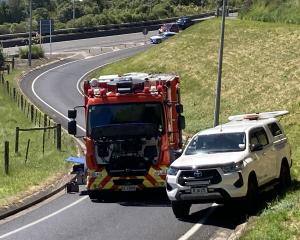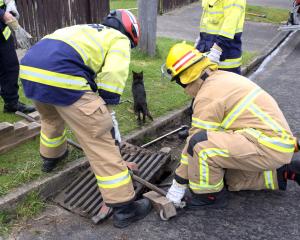
After decades of disregard, last year memorials to the 37 women killed in the Seacliff Mental Hospital fire were unveiled at the former hospital and Andersons Bay cemetery.
However, the legacy of the 75th anniversary events will reach further than that, thanks to the generosity of the families of the women killed in the 1942 blaze.
People came not only from around New Zealand but from overseas to the December events to honour the women killed at Seacliff.
They were asked to make a donation to mental health services in lieu of other tributes, and this week organisers of the Seacliff memorial presented the money to the Otago Mental Health Support Trust.
"It is a significant donation in many ways and it will be treated as such," trust chairwoman Marian Hobbs said.
"Mental health isn’t an issue where everything is answered with a pill or by being put into an institution.
"It is something which is in our community and is something we need to deal with in the community."
Today, mental health issues are much better understood and the provision of adequate and appropriate services is recognised.
However, on December 8, 1942, the women in ward 5 at the hospital had an assortment of mental health needs — many of which would not be treated by institutional care today.
Some had post-natal depression, some had post-traumatic stress disorder, some were classed as "stroppy wives", some had dementia, while others had diagnosable problems such as bi-polar disorder.
However, they were all locked in for the evening when a fire, sparked by a still unknown source, set the wooden building ablaze.
Only two women in the ward survived.

"All that the family members got was a telegram saying ‘so and so died in a fire’," co-organiser Jean Park said.
"There was no funeral service, which was why 75 years later people were so emotional about it. It was long past time to acknowledge these women."
One overwhelming message came from the families of those killed in the fire: it was an event which no-one talked about.
Remains were interred in unmarked graves.
Some families did not even acknowledge relatives had died because of the stigma of mental illness.
Hence, many families likely do not know they had a relative in Seacliff.
Mrs Park and her team could only find 14 families of the 37 women when inviting people to take part in December’s services — the veil of secrecy made it a mission to get the correct names of the 37 women on the memorials.
The December events brought families together.
People who had never met or not seen each other for years were brought together by their ancestral link.
"We knew grandma had a sister who died in the fire but we didn’t know the circumstances until I grew up and started looking," Wendy Hellyer, who unveiled the Andersons Bay memorial, said.
"It had been a pipe dream of mine for 30 years for these women to be recognised, and now they have been thanks to a real team effort."
"Some didn’t have any descendants because they were relatively young," Mrs Park said.
"But for others, the names were not publicised widely, and people just don’t know."
While the families were those most directly affected by the fire, they were not the only ones who mourned the women of Seacliff.
After the Andersons Bay service a smaller plaque was unveiled at Seacliff. Families attended as well, but so did many locals.
"Members of the community came and they talked about the impact of the fire on the community then and even now," Mrs Park said.
"They talked about some of the people basically becoming members of their own family, and you don’t hear about that, you don’t hear about the kindness.
"People did what they could, and that was a really different perspective on the lunatic asylum."
The women are full of praise for the role the Dunedin City Council, Dunedin Monumental Masons and Hope and Sons played, both in time and contributions to the event.
More people attended than organisers had initially hoped, and everyone had gone the extra mile.
"People said they felt it was important to be involved, that they be there," Mrs Park said.
Seventy-five years on, many people are still there for the women of Seacliff.














